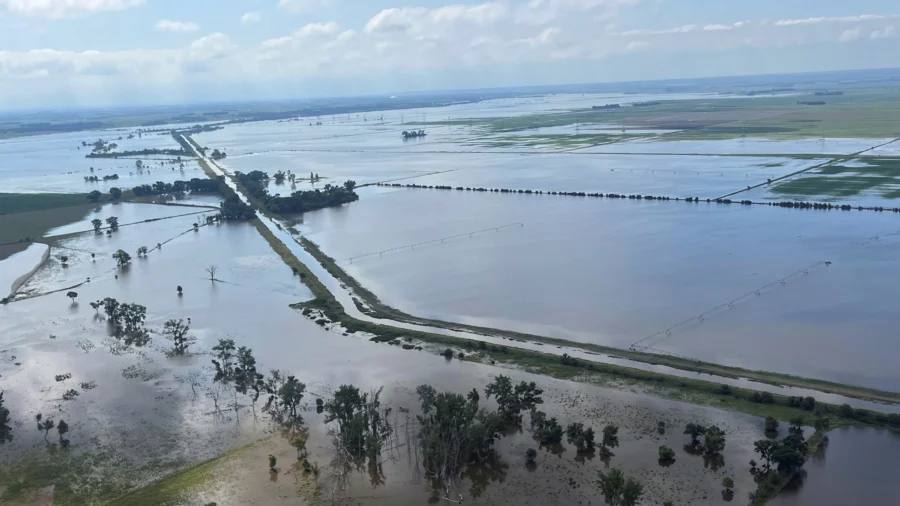DES MOINES, Iowa—Kathy Roberts has almost nothing left.
The South Dakota resident escaped flooding Sunday night with her cat and the clothes on her back, KTIV-TV reported.
“I heard screaming outside and looked outside and I had neighbors that had water rushing into their place and water was slowly rising in my driveway,” Ms. Roberts said. “Within eight minutes, I was leaving my house and driving through water that was up over my step rails on my jeep.”
In the residential development where Ms. Roberts lived along McCook Lake in North Sioux City, the devastation was coming into focus as floodwaters began to recede, exposing collapsed streets, utility poles, and trees. Some homes were washed off their foundations.
There was no water, sewer, gas, or electrical service in that area, Union County Emergency Management said Tuesday in a Facebook post.
South Dakota Gov. Kristi Noem said in a post on the social platform X Tuesday night that people needed to stay out of the area unless escorted by public safety officials.
“We are working on a schedule for families to get their belongings,” Ms. Noem said. “Until then, downed power lines, sinkholes, and other threats make it too dangerous to go in alone.”
A vast swath of lands from eastern Nebraska and South Dakota to Iowa and Minnesota has been under siege from flooding from torrential rains since last week, while also experiencing a scorching heat wave. Up to 18 inches (46 centimeters) of rain have fallen in some areas, and some rivers rose to record levels. Hundreds of people were rescued, homes were damaged and at least two people died after driving in flooded areas.
Tornado warnings, flash flooding, and large hail Tuesday night also added insult to injury for some people in the Midwest.
The National Weather Service on Tuesday afternoon and evening issued multiple tornado warnings in parts of Iowa and Nebraska as local TV news meteorologists showed photos of large hail and spoke of very heavy rain. No damage from tornadoes was immediately reported and the extent of any hail damage wasn’t clear.
The weather service on Tuesday night also extended flood warnings for multiple rivers in South Dakota, Nebraska, Iowa, and Minnesota. Earlier Tuesday, floodwaters breached levees in Iowa, creating dangerous conditions that prompted evacuations.
The sheriff’s office in Monona County, near the Nebraska border, said the Little Sioux River breached levees in several areas. In neighboring Woodbury County, the sheriff’s office posted a drone video on Facebook showing the river overflowing the levee and flooding land in rural Smithland. No injuries were immediately reported.
As new areas flooded Tuesday, some cities and towns were cleaning up after the waters receded while others downstream were piling sandbags and taking other measures to protect against the oncoming swelled currents. Some normal, unassuming tributaries ballooned into rushing rivers, damaging homes, buildings, and bridges.
South Dakota state geologist Tim Cowman said that the five major rivers in the state’s southeastern corner have crested and are slowly dropping.
In Sioux City and Woodbury County, Iowa, officials responded to residents’ complaints that they had received little warning of the flooding and its severity. Sioux City Fire Marshal Mark Aesoph said at a news conference Tuesday that rivers crested higher than predicted.
“Even if we would have known about this two weeks ago, there was nothing we could do at this point. We cannot extend the entire length of our levee,” Sioux City Fire Marshal Mark Aesoph said.
Water had spilled over the Big Sioux River levee, and Mr. Aesoph estimated hundreds of homes likely have some internal water damage.
Homes on the south side of Spencer, Iowa, near the Little Sioux River are unlivable as water has reached the main floor, resident Ben Thomas said. A lot of people in town are facing a “double whammy,” with homes and businesses affected.
Officials in Woodbury County said around a dozen bridges over the Little Sioux River had been topped by flood water, and each would need to be inspected to see if they can reopen to traffic.
President Joe Biden approved a major disaster declaration for affected counties in Iowa on Monday, a move that paves the way for federal aid to be granted.
Forever Wildlife Lodge and Clinic, a nonprofit animal rescue, in northwest Iowa has answered over 200 calls since the flooding started, said licensed wildlife rehabilitator Amanda Hase.
Ms. Hase described the flooding as “catastrophic” for Iowa wildlife, which are getting washed out of dens, injured by debris and separated from each other. She and other rehabilitators are responding to calls about all kinds of species, from fawns and groundhogs to bunnies and eaglets.
“I’ve never seen it this bad before, ever,” she said.
Further to the east in Humboldt, Iowa, a record crest of 16.5 feet (5 meters) was expected Wednesday at the west fork of the Des Moines River. Amid high temperatures and humidity, nearly 68,000 sandbags have been laid, according to county emergency manager Kyle Bissell.
Ms. Bissell told reporters Tuesday that flooding had begun in some backyards and was reaching up to foundations. Humboldt is home to nearly 5,000 residents.
The weather service also predicted more than two dozen points of major flooding in southern Minnesota, eastern South Dakota, and northern Iowa.
Many streams, especially with additional rainfall, may not crest until later this week as the floodwaters slowly drain down a web of rivers to the Missouri and Mississippi. The Missouri will crest at Omaha on Thursday, said Kevin Low, a weather service hydrologist.
North of Des Moines, Iowa, the lake above the Saylorville Dam was absorbing river surge and expected to largely protect the metro area from flooding, according to the Polk County Emergency Management Agency. The U.S. Army Corps of Engineers projected Tuesday that water levels at Saylorville Lake will rise by more than 30 feet (9 meters) by the Fourth of July.


